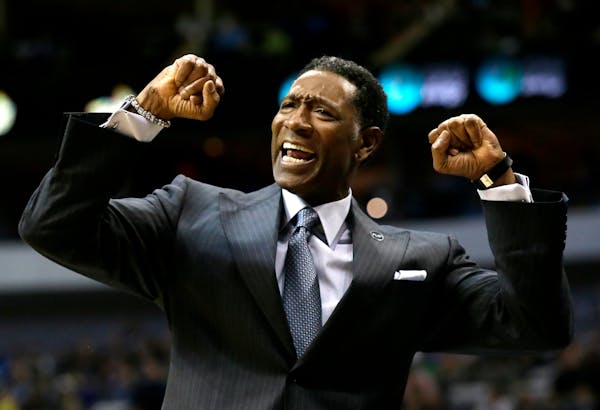The Timberwolves' best consistently used lineup this season remains the starting five often seen early in the season consisting of Ricky Rubio, Andrew Wiggins, Karl-Anthony Towns, Kevin Garnett and Tayshaun Prince. Wiggins and Towns provided the offense. Rubio provided defense and passing. The two veterans provided defense. It worked out to a net-rating of plus-9.1 points per 100 possessions in the 275 minutes when those five were on the court at the same time.
But one could also make the argument that the current starting five — Rubio, Towns, Wiggins, Zach LaVine and Gorgui Dieng — is the team's best offensive lineup. Those five have played the most minutes together — 356 — of any five-man group for the Wolves this season. Their net-rating is a plus-2, which might not sound that great until you consider two things: 1) the team average is a minus-4, so that's 6 points better. 2) It's a lineup consisting of a 20-year-old, two players who just turned 21 and nobody who has played more than 270 career NBA games. They're often going against the best players from other teams, many of them seasoned stars, and more than holding their own.
The bulk of this lineup's action has come in the second half of the season, and some numbers provided by Wolves stat guru Paul Swanson show some interesting things both about those five and the Wolves' offense starting at the midpoint and going forward:
*In Games 42-67 (the 26 games in the second half of the season so far), the Wolves are third in the NBA in both field goal percentage (.483) and true shooting percentage (.569, a stat that takes into account three-pointers and free throws). Much of that time coincides with LaVine's move from combination guard (splitting time at shooting guard and point guard) to being almost exclusively a shooting guard in the starting lineup. He's played 80 percent of his minutes at shooting guard in the second half of the season, including 97 percent in the past 17 games.
The flip side of that is that this isn't nearly as good of a defensive lineup as the Wolves had with Prince and Garnett in the mix. Interim coach Sam Mitchell specifically has implored LaVine to play better D. So far, though, teams have been feasting on the Wolves in the second half of the season to the tune of a .572 true shooting percentage — making the Wolves the third-worst in that category. So in spite of being third-best on the offensive side, the gains in the win-loss column haven't been dramatic. The Wolves have only kept one opponent under 100 points in the last 18 games, going 7-11 in that span.
*Within those improved offensive numbers, we see explanations. The two most interesting numbers show the Wolves are shooting higher-percentage shots and making more of them — a good combination for an efficient offense.
In the first half of the season, the Wolves as a team shot 60.3 percent on attempts from the "restricted area" (3 feet or less, essentially), and they attempted 25.6 such shots per game. In the 26 games since the start of the second half, they've made 66.5 percent of those shots and are attempting 27.9 such shots per game. Ricky Rubio, Gorgui Dieng and Andrew Wiggins, in particular, have improved greatly in that stretch.
On the flip side, the Wolves are settling for fewer of the dreaded "long 2s," defined by Swanson as two-pointers from outside the paint. In the first half, the Wolves shot 37.7 percent on those attempts and tried 28.4 of those shots per game. From Game 42 on, they've boosted the percentage to 39.8 and dropped the number of attempts to 25.3.
Some of that could be a product of improved chemistry or a shift in offensive philosophy. Some of it could be directly attributable to LaVine playing less point guard — which often resulted in a stagnant offense that relied on jump shots — and playing more shooting guard, where he gets better looks on jumpers (as you can see by his improved long 2 percentage) and attacks the basket with more success (as you can see by his improved numbers in the paint).
Again, though, opponents have also increased their offensive efficiency in that span (those numbers in the red for opponents in the above charts are second-half gains for opponents, net losses for the Wolves). In the same time frame, too, the Wolves' bench has been perilously thin — often giving away leads the starters have helped build early on, a recurring theme for the season.
If this starting five continues to not only add onto a very good offensive foundation but also nudges up its defense a notch or two … while the organization builds a more functional second unit … that could be the recipe, finally, for some sustained organizational success.
In heated western Minn. GOP congressional primary, outsiders challenging incumbent

Minnesota Sports Hall of Fame: A class-by-class list of all members

This retired journalist changed professional wrestling from Mankato

